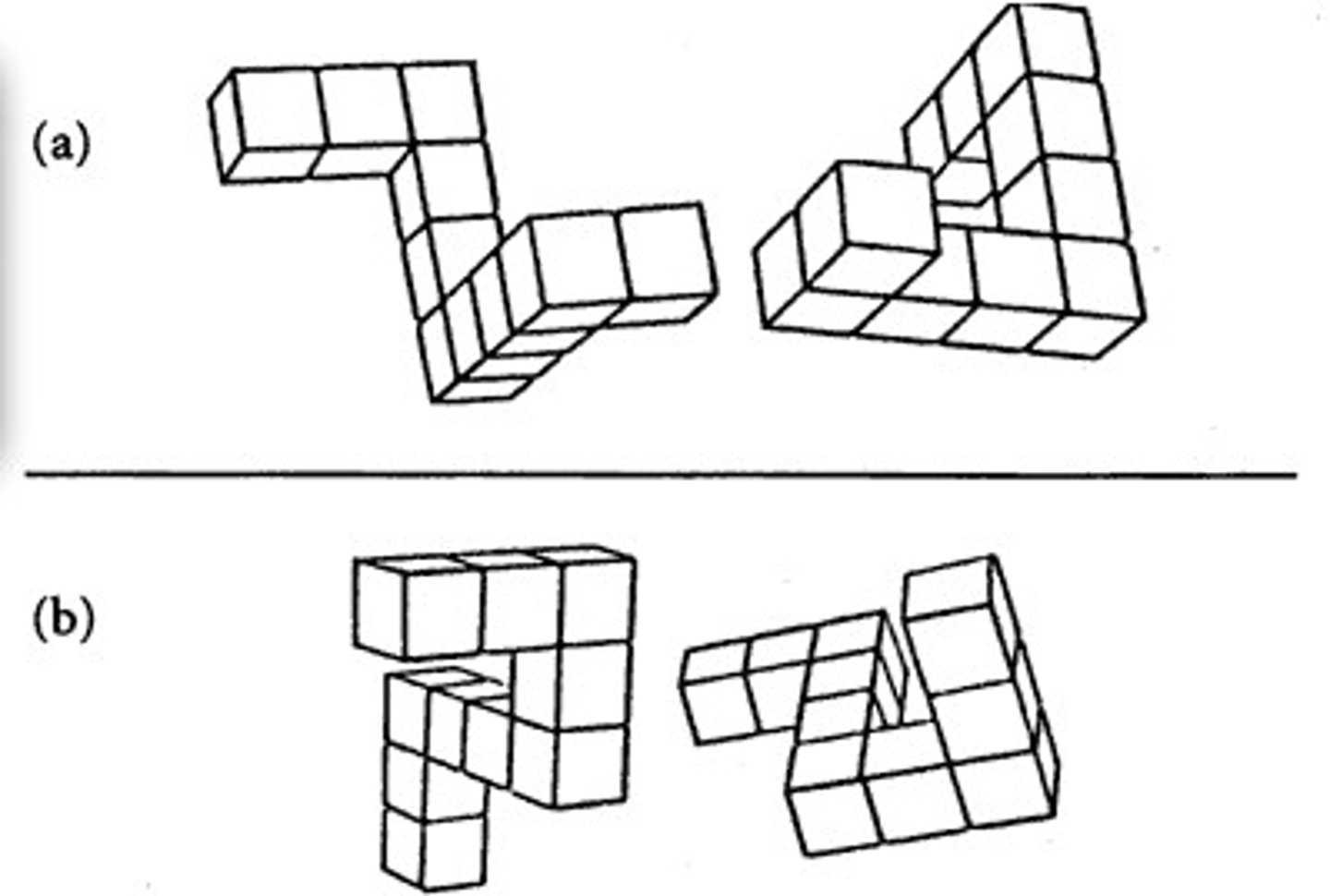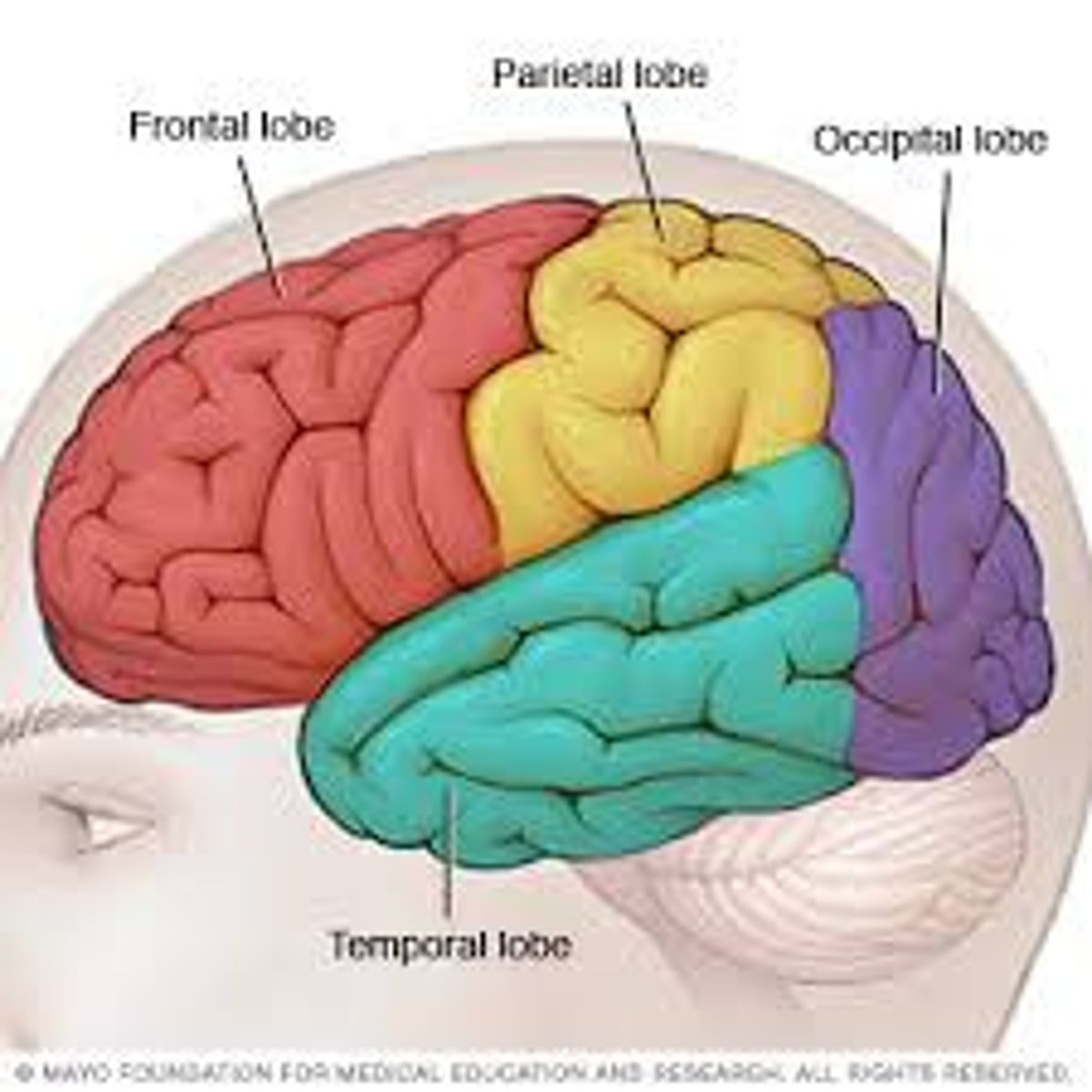PSY 201 EXAM 4- University of Oregon
1/73
There's no tags or description
Looks like no tags are added yet.
Name | Mastery | Learn | Test | Matching | Spaced |
|---|
No study sessions yet.
74 Terms
Representing verbal info
retain gist/ meaning vs. exact wording
when told a story people retain the gist of the story not the exact wording
Visual-spatial information
stored as propositions (verbal statements) or as visual images ( a visual representation that preserves spatial and form information)
Evidence for a visual-spatial format
3 ways:
1) Scanning experiments
2)mental rotation experiments
3) eidetic imagery
Scanning experiments
memorize map of island. Then, imagine map of island. Scan from location x to location y. RT is proportional to distance between the 2 points
mental rotation experiments
presents subjects with letters some of which are mirrors reversed and rotated at varying degrees from upright
Task--identify as quickly as possible if letter is mirror reversed
Results: time required to respond depends on degree of rotation
Evidence: that subjects mentally rotate figure to upright position to compare it with an image stored in memory

eidetic imagery
long lasting and detailed images of a visual scene. Can be scanned or "looked at"
representation of Concepts (word meanings)
Concept refer to categories of things
Prototype theory of concepts
picture-like representation of typical or average member of a category
I.e. word meanings/concepts are not just definitional, but are represented by prototypes (the average/typical member)
Hierarchical model of semantic (conceptual) memory
Each category has properties which are stored as high as possible in the hierarchy lower categories inherit the properties of the higher categories to which they belong
Links between different categories and between categories and their properties
basic level of hierarchy
middle level,the level at which people best think about and categorized an object
why are having categorical representations useful?
Rapid organization,classification, and prediction of aspects of experiences
Also helps in reasoning and communicating about the world
forgetting curve (short term)
have similar shapes
i.e.learning faces, pictures, etc
forgetting curve (long term)
have different shapes,
i.e. a foreign language test
Forgetting is due to (3 things)
decay,interference, or lack of appropriate retrieval cues
Retroactive interference
inhibitory effect of new material on old (e.g. learning a new phone # or address suddenly makes it hard to retrieve the old info)
Proactive interference
Inhibitory effect of old material on new (e.g. initially learning how to pronounce a word wrong-"colonel" affects one's ability to do it right in the future).
(is greatest when the different learning tasks involve similar items)
Retrieval cues
Recall vs. Recognition
Recalling info
no stimulus present to help
i.e. essay exams
Recognizing info
stimulus is there providing retrieval cues
i.e. multiple choice exam
Context-dependent memory
refers to improved recall of specific episodes or information when the context present at encoding and retrieval are the same
i.e. scuba divers learn words either on land or underwater. Better recall if tested in same environment
state-dependent memory
memory retrieval is most efficient when an individual is in the same state of consciousness as they were when the memory was formed
i.e. word learning with or without marijuana
Remembering
an active inferential process influenced by a person's general knowledge of the world
Bartlett (1932)-- remembering pictures and stories
students are told a old native story and asked to remember it and they tend to 1) simplify the story; 2) changed the emphasis, 3) assimilate--change details to fit their own cultural background or knowledge
Remembering pictures→ serial reproduction of pictures
10 subjects. Subject 1 saw the original figure and was asked to reproduce it ½ hour later. Subject 2 saw subjects 1's reproduction and so on. The figure shows the original drawing and the 10 serial reproductions, illustrating a massive reconstruction process
Loftus
information added after an event can affect people's apparent memory
i.e.Traffic accident film
Other experiments on remembering
indicate that new information supplements or competes with (or. replaces) the original information
i.e. When misleading information is pitted against original memory subjects perform poorly . However, when misleading info not pitted against original information, subjects perform just as well as non-misled subjects
Repressed memories
repressed memories of traumatic events (such as childhood physical or sexual abuse) that resurfaces later in life
False memory syndrome
describes a condition in which a person's identity and relationships are affected by memories that are factually incorrect but that they strongly believe
(Loftus and other question the accuracy of repressed memories, especially those that are recovered during psychotherapy)
work at the UO by Dr. Freyd and by other in the field show the following
1.Memory accuracy and memory persistence (recovered or continuous) are independent. We can have memories that are largely true of false whether recovered or continuous
2.Repressing memories of abuse is more likely when the perpetrator is a caregiver, such as a parent than when they are not the caregiver such as a family friend or stranger
3.Forgetting occurs for many different types of trauma
The in class video (about the woman that was raped) showed what?
that picking a person from a lineup who looks similar to the criminal (who is not in the lineup) can later lead to problems in correctly identifying the real criminal
Anatomy of Sensory systems
Primary sensory areas→ high level sensory areas (It cortex) ←> Hippocampus/Amygdala
what are "medial temporal lobe" structures
hippocampus and amygdala

Damage to the IT cortex
deficits in pattern recognition (e.g. visual agnosia) → this is where long term memories are stored
Damage to Medial Temporal Lobe (MTL) Structures (Hippocampus and Amygdala) Result in:
anterograde and retrograde amnesia
Anterograde Amnesia
difficulty in establishing new memories
unable to form new declarative memories (episodic and semantic memories)
Retrograde Amnesia
difficulty in retrieving memories formed just before the onset of amnesia (i.e. before the time that the damage occurred) IN other words, lose youngest memories (i.e. newly established memories which are the most vulnerable)
Case HM
surgery which removed his hippocampus and amygdala to treat severe epilepsy
Case HM: what was lost
declarative memories (Anterograde amnesia)
e.g.memory for pictures,new faces, anything read about in a magazine, new address of family, etc
and
Retrograde Amnesia-- lost declarative memories up to -1 year before the surgery
Case HM: what was preserved
STM (can correctly repeat 6-7 digits), language, social skills, personality, memory for the remote/distant past (everything up to 1 year before his surgery) & procedural memory
Could learn and retain new procedural skills/memories
(E.g. sensory-motor skill learning (tracing mirror image pattern); conditioning)
consolidation
Need interaction between MTL structures and cortex to establish new long-term declarative memories in cortex
(the integration of new memories with old ones) and it takes time
language is
creative, structured, meaningful, referential, interpersonal/communicative
creative
a limitless # of thoughts can be expressed in a limitless # of ways
Structured
sounds are combined into words, and words into sentences according to rules (i.e. grammar)
Meaningful
ideas are conveyed by individual words and how they are organized into sentences
i.e. the cat bit the dog
The dog bit the cat
(Same words by different meanings)
Referential
it refers to and describes things and events in the world
i.e.Children must learn the mapping (between words and things/events in world)
Interpersonal/Communicative
has a social function
i.e.Can you tell me the time
Competence
what one knows
Implicit knowledge
knowing what's right
i.e.plural,wordness,syntactic, competence
Explicit knowledge
explain in terms of formal rules (grammar)
i.e. Most knowledge is implicit, unless you are a linguist, English major, or English is a 2nd language
Performance
what one does; how knowledge is used (often make mistakes). Competence is usually better than performance
How many languages in the world?
7000 different languages in the world today
What is the basic hierarchical structure?
Sounds(phonemes)--> words (morphemes)--> phrases→ sentences→ conversations
phoneme
elementary sounds of speech
There are vowel (e.g. "e") and consonant (e.g. "t') sounds
Are NOT letters (e.g. to,too,two,through,threw,shoe,clue,view)
11-144 of these in any given language
Combining these-- is rule governed: some sound combinations are pronounceable but not allowed
e.g. "tl" is not allowed at the beginning of a word (in english)
Morpheme
the smallest meaningful unit of language
Can be:
Word (e.g. help, love)
Word Stem (e.g. spir,ceive,duce)
Prefix (e.g. re-,dis-)
Suffix(e.g.-less,-ful)
2 types of these
Content words
carry the main meaning of the sentences. Includes nouns,verbs, adjectives, and adverbs
Function words
grammatical words. Includes articles (a,the), conjunctions (and,but), prepositions (in,of), and prefixes and suffixes (-ing,-ed,-s)
syntax
the rule governed system for grouping of words together into phrases and sentences
e.g. English word order-SVO
(subject,verb,object)
Organizing Words into Meaningful Sentences
Sentences introduce somes concept that they are about, the subject ( or noun phrase of the sentence, and then propose or predicate something about that concept, the predicate (or verb phrase) of sentence
E.g. " The boy (subject) hit the ball (predicate)"
Sentences can have the same meaning (same deep structure) but different surface phrase structures (different surface structure)
Deep structure
the implicit meaning of sentences
surface structure
the sound and order of words
passive sentence structure
E.g. "the ball was hit by the boy"
focuses on the "done-to" (the ball) vs. the "doer" (the boy)
active sentence structure
E.g. "the boy hit the ball"
focuses on the "doer" (the boy) vs. the "done-to" (the ball)
Sentences can have the same surface structure but different deep structure (i.e. meanings)
E.g. "Visiting relatives can be boring"
E.g. "Smoking volcanoes can be dangerous"
Similar to ambiguous figures (1 form, 2 interpretations). News headlines are often guilty of being ambiguous
One can tell whether a sentence is grammatical or not, even if it doesn't make sense (or contains non-words)
E.g. "colorless green ideas sleep furiously." vs. "furiously idea colorless green sleep"
spoonerisms
"Slips of the tongue"
errors in speech production in which two elements in a sentence (e.g. phonemes,morphemes) are mistakenly interchanged in position
language comprehension
Strong bias in English to interpret sentence as: doer, act,done-to ( i.e. subject, verb, object)
use grammatical morphemes to interpret sentences that don't follow the doer, act, done-to
format
Where is language located for most people
left hemisphere
Broca's Aphasia
syntactic deficit(sentence grammar),problems interpreting and producing grammatical
morphemes/words (OK with content words); trouble producing language (telegraphic
speech)
telegraphic speech
use as few words as possible to get across meaning (using mostly content words vs. function/grammatical words. Also deficient in use and understanding of function/grammatical words)
Wernicke's Aphasia
semantic deficits(meaning/content) => serious problems in comprehending the
meaning of language; superficially fluent speech without meaning (deficient in
content words but not grammatical morphemes/words)
A Broca's Aphasic will have brain damage in the ____ lobe causing a _____ deficit; while a Wernicke's Aphasic will have brain damage in the ______ lobe causing a ______ deficit
frontal;syntactic;temporal;semantic
Language in humans requires the ability to
1.Represent objects or events with symbols (language is referential)
2.Combine symbols in a systematic way (syntax)
Older ape research: ( on chimpanzees- e.g. Washoe,Nim)
Words?:can acquire a substantial number of "words"
E.g. after 4 years, Washoe learned -130 signs for objects (banana,han), actions (bite,tickle), and action modifiers (enough,more).
Syntax?:e.g. does Washoe know the difference between: "mama tickles Washoe" and "washoe tickles mama?"
Some researchers/trainers claimed the apes could string words into meaningful sentences and even coin new phrases (e.g. water bird" for a swan; "cookie rock" for a stale pastry)
Research on Bonobo Chimps
Kanzi. Given no formal or explicit language instructions;uses a lexigram keyboard. More careful studies
Words?:By 6 years matches -200 spoken English words to appropriate to most of -300 novel sentences
Comprehension?:Researchers suggest that Kanzi is aware that communication is social interaction-many utterances directed towards social games (vs. food)
Syntax?: limited--tends to consistently produce action-object sequences
e.g. hit ball, Chase/hide someone